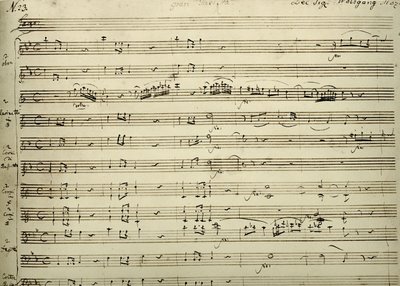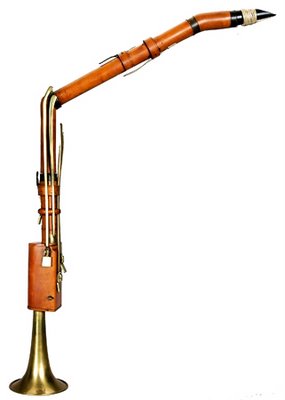
Mozart, Gran Partitta, K. 361, holograph score, Library of Congress |
A near-capacity crowd filled the seats of Coolidge Auditorium on Thursday night, for the latest
free concert from the Library of Congress. The draw was the chance to hear members of the
Orchestra of the Age of Enlightenment, one of the best-regarded historically informed performance ensembles, give a rare live performance of Mozart's
Gran Partitta. At the last minute, the group of eight woodwind players, accompanied by four horn players and a double bassist, traveled to the U.S. without their first bassoonist, Andrew Watts. Fortunately, American bassoonist
Andrew Schwartz, of the Little Orchestra Society and other groups, stepped in to make the concert happen.
The evening opened with another wind serenade, K. 375, a wind octet version of a piece that Mozart composed shortly after he arrived permanently in Vienna. The work was intended for the group of crack wind players at the Imperial Court, the Kaiserlich Königlich Harmonie, which included clarinetist Anton Stadler. All eight players are tested by demanding passages, and the evening featured some remarkably virtuosic technique, especially given the unruly nature of the older instruments involved. In particular, the materials involved tend to create more problems with condensation, something that was commented upon by first clarinetist Antony Pay to explain the players' frequent "mopping out" of their instruments. The Masonic key of this serenade, E-flat major, and the chordal knocking motif of the opening bars reminded me, obliquely, of
The Magic Flute. (Mozart and Stadler were members of the same Masonic lodge, and Mozart wrote a number of parts for him, including
obbligati in La Clemenza di Tito.) The OAE gave a jolly reading of the piece, with a melancholy trio in the first menuetto and a fast, almost carnivalesque rondo in the finale.

"The basset horn, which sounds with a diffuse golden tone and looks like a broken clarinet with a nozzle at the base."
-- Daniel Ginsberg, Washington Post |
The basset horns, three of them, did not appear until the second set of pieces, five terzetti for basset horns by Anton Stadler. The older version of the instrument is mellow, with the chalumeau smoothness of its relative, the clarinet. Stadler was probably writing these little badineries for himself and perhaps students, as the first part mostly dominates. The accompaniments spun out by the subservient lower parts are often little more than music-boxy hurdy-gurdy sounds, supporting chipper, if pedestrian melodies. The five movements are based on dance rhythms, but there are few surprises, except for the chromatic, almost bluesy coloring at the end of the final phrases in the last movement.
The inferior nature of these compositions was made explicit by the little bon-bon the three players offered as dessert, Mozart's
Canonic Adagio (F major, K. 484d [410]). If the
Gran Partitta, now dated to 1784, shows leagues of development in Mozart's compositional style over K. 375, this enigmatic miniature, from late 1785 (actually scored for two basset horns and bassoon but played here with the three basset horns), is even more striking. Certainly shaming Stadler's little ditties, the Adagio feels quite like a sort of personal experiment, Mozart exploring the counterpoint and adventurous harmony he had been studying in the music of J. S. Bach. One audience member called out for the little piece, over in a minute or two, to be played again, but he was not obliged.
The Library of Congress owns the holograph score (page shown above) of the
Gran Partitta (Serenade in B-Flat Major, K. 361), and they have published a facsimile edition of it. The critical edition, edited from the holograph and other primary sources by Neal Zaslaw and Daniel Neeson for the
Neue Mozart-Ausgabe, finally dispelled the misconceptions about this work, which date back to "editions" made in the years after the composer's death. It added a level of significance to see the page in Mozart's hand in a case outside the auditorium. While the intellectual and technical qualities of this concert certainly impressed, musically one sensed something missing at times. This was typified in the
Gran Partitta's glorious Adagio movement (which makes a memorable appearance in the film
Amadeus), dashed off at a tempo closer to Andante than Adagio. The result was disappointingly prosaic. All, or almost all, of the surface details were there, but at times like this it was only an outside sheen.
The next concert in the Library of Congress series (December 15, 8 pm) is an all-Schumann program played by Joshua Bell (violin), Paul Neubauer (viola), Steven Isserlis (cello), and Jeremy Denk (piano).























































No comments:
Post a Comment